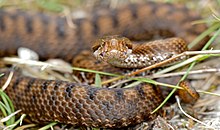Our website is made possible by displaying online advertisements to our visitors.
Please consider supporting us by disabling your ad blocker.
Vipera aspis
| Vipera aspis | |
|---|---|

| |
| Scientific classification | |
| Domain: | Eukaryota |
| Kingdom: | Animalia |
| Phylum: | Chordata |
| Class: | Reptilia |
| Order: | Squamata |
| Suborder: | Serpentes |
| Family: | Viperidae |
| Genus: | Vipera |
| Species: | V. aspis
|
| Binomial name | |
| Vipera aspis | |
| Synonyms[4] | |
| |
Vipera aspis is a viper species found in southwestern Europe. Its common names include asp, asp viper,[5] European asp,[6] and aspic viper,[7] among others. Like all other vipers, it is venomous. Bites from this species can be more severe than from the European adder, V. berus; not only can they be very painful, but approximately 4% of all untreated bites are fatal.[7] The specific epithet, aspis, is a Greek word that means "viper."[8] Five subspecies are currently recognized, including the nominate subspecies described here.[9]
- ^ Claudia Corti, Juan M. Pleguezuelos, Valentin Pérez-Mellado, Rafael Marquez, Marc Cheylan, Philippe Geniez, Ulrich Joger, Hans Konrad Nettmann, Benedikt Schmidt, Andreas Meyer, Roberto Sindaco, Antonio Romano, Iñigo Martínez-Solano (2024). "Vipera aspis". IUCN Red List of Threatened Species. 2024: e.T61591A137859549. doi:10.2305/IUCN.UK.2024.RLTS.T61591A137859549.en. Retrieved 23 September 2024.
{{cite journal}}: CS1 maint: multiple names: authors list (link) - ^ The Reptile Database. www.reptile-database.org.
- ^ Boulenger, G.A. 1896. Catalogue of the Snakes in the British Museum (Natural History). Volume III., Containing the...Viperidæ. Trustees of the British Museum (Natural History). (Taylor and Francis, Printers.) London. xiv + 727 pp. + Plates I.- XXV. (Vipera aspis, pp. 481-485.)
- ^ McDiarmid RW, Campbell JA, Touré T. 1999. Snake Species of the World: A Taxonomic and Geographic Reference, Volume 1. Herpetologists' League. 511 pp. ISBN 1-893777-00-6 (series). ISBN 1-893777-01-4 (volume).
- ^ Mallow D, Ludwig D, Nilson G. 2003. True Vipers: Natural History and Toxinology of Old World Vipers. Krieger Publishing Company, Malabar, Florida. 359 pp. ISBN 0-89464-877-2.
- ^ Vipera aspis at Munich AntiVenom INdex
- ^ a b Street D. 1979. The Reptiles of Northern and Central Europe. London: B.T. Batsford Ltd. 268 pp. ISBN 0-7134-1374-3.
- ^ Gotch AF. 1986. Reptiles – Their Latin Names Explained. Poole, UK: Blandford Press. 176 pp. ISBN 0-7137-1704-1.
- ^ "Vipera aspis". Integrated Taxonomic Information System. Retrieved 13 August 2006.
Previous Page Next Page



